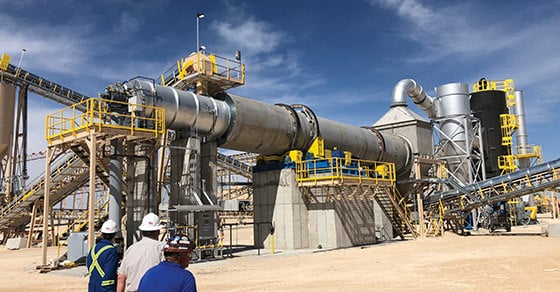The performance of a rotary dryer is vital to maximizing process efficiency and capacity in any industrial process setting. While a well-designed dryer will yield few problems of its own, various factors can cause the performance of the overall drying operation to degrade.
Process audits such as those offered by the FEECO Customer Service Team are an invaluable tool to identify issues and increase capacity and fuel efficiency.
What is a Rotary Dryer Process Audit?
A process audit is a thorough inspection and analysis of rotary dryer operation. Unlike an equipment audit, which focuses on the mechanical and structural components of a rotary dryer, a process audit focuses on a dryer’s overall performance. Both the dryer and exhaust system are typically examined.
There are three primary reasons for conducting a process audit:
To increase fuel efficiency
The most common reason for conducting a dryer process audit is to check and potentially improve fuel efficiency. An audit allows a process engineer to gather all the data and systematically determine how dryer efficiency could be improved.
To increase capacity
It is often desirable to improve capacity without purchasing a new dryer. A dryer process audit will identify issues that are keeping the dryer from reaching its potential. With a dryer capacity increase, fuel efficiency will also often improve.
Explore a change in flight/lifter design
Flight/Lifter design is key to efficient dryer operation. The wrong type of lifter can result in build-up problems and poor showering. Often the design of the lifter changes along the length of the dryer because the material properties change.
In addition to the reasons listed above, process audits can also serve as a valuable opportunity to gather benchmark data. When conducted regularly, the analysis of benchmark data over time can reveal more subtle indications of a potential problem.
Common Reasons for Dryer Issues
While there are many possible reasons why a dryer may be exhibiting issues, the most common reasons are:
Air In-leakage
The most common reason a drying operation is experiencing issues is because of ambient air leakage. Air in-leakage can reduce the gas temperature at the dryer feed end, resulting in reduced capacity and higher fuel consumption. Leakage at the discharge end adds extra volume to the gas handling system.
Improper Operation
Improper operation can be the result of several issues. This might include:
- A drying gas temperature that is too low
- Feed variability
- Inadequate control system
Flight/Lifter Design
Flight, or material lifter design has a significant impact on the end product and overall dryer performance. Flights must be designed around the characteristics of the feed material in order to yield optimal performance and results. If feed or process conditions change, flight design and pattern may need to be re-evaluated. If wet or sticky feed is consistently building up in the feed end of the dryer, for example, this may indicate that the lifter design is not appropriate for the feed.
Lifters are also the key to achieving higher dryer efficiency; by using the correct lifter design, including shape and size, the showering of material in the dryer can be improved, leading to better gas-to-solids contact and improved drying.
What a Dryer Process Audit Looks Like
A rotary dryer process audit will look different depending on the reason for the audit.
FEECO process audits begin with the Customer Service Engineer discussing the issues and goals of the process audit with the plant’s engineers and ideally, operators. Operators are typically most familiar with the process and material, making them a valuable resource in an audit. This initial discussion often provides a direction for the process audit, or gives the Customer Service Engineer an idea of where it might be best to start.
The Customer Service Engineer also requests all available operating data to be gathered for review. If a problem is not immediately visible, the engineer will begin by conducting a number of tests and measurements on the operational unit.
The data typically obtained includes:
- Inlet and outlet temperatures of material
- Fuel consumption
- Feed and product rate, composition, and moisture content
- Baghouse and differential pressure
- Dryer pressure
- Drum internal configurations
- Exhaust gas temperature, flow rate, and composition
If the dryer is part of a larger agglomeration/granulation process, the agglomeration portion of the process may also require investigation. Parameters examined might include:
- Binder feed rate
- Binder concentration
- Spray nozzles
- Spray locations
The Customer Service Engineer utilizes the data gathered during testing to systematically assess where an issue is originating. This starts by performing a heat & mass balance and checking the dryer operation against what is expected. Upon a thorough analysis, the Customer Service Engineer will provide a comprehensive audit report consisting of the data collected, a summary of the work that was carried out, and most importantly, recommendations to optimize the process or resolve any issues.
Making operational or equipment modifications identified by the Customer Service Engineer will help improve process performance. As a result, the following benefits may be observed (depending on the scenario):
- Improved product quality
- Reduced fuel and/or energy costs
- Increased production
- Reduced equipment wear
- Minimized downtime
- Lower maintenance costs
Conclusion
Drying in an industrial process setting is integral to achieving the required product quality. A drying operation that is not running as designed can cause a variety of issues, and may originate from any number of sources. For this reason, rotary dryer process audits are an effective tool to improve process operation.
The FEECO Customer Service Team is highly experienced in dryer performance and can efficiently assess any drying operation for optimization and issue resolution. They can also provide a range of additional rotary dryer services to keep your equipment running its best.
For more information on process optimization, contact us today!



